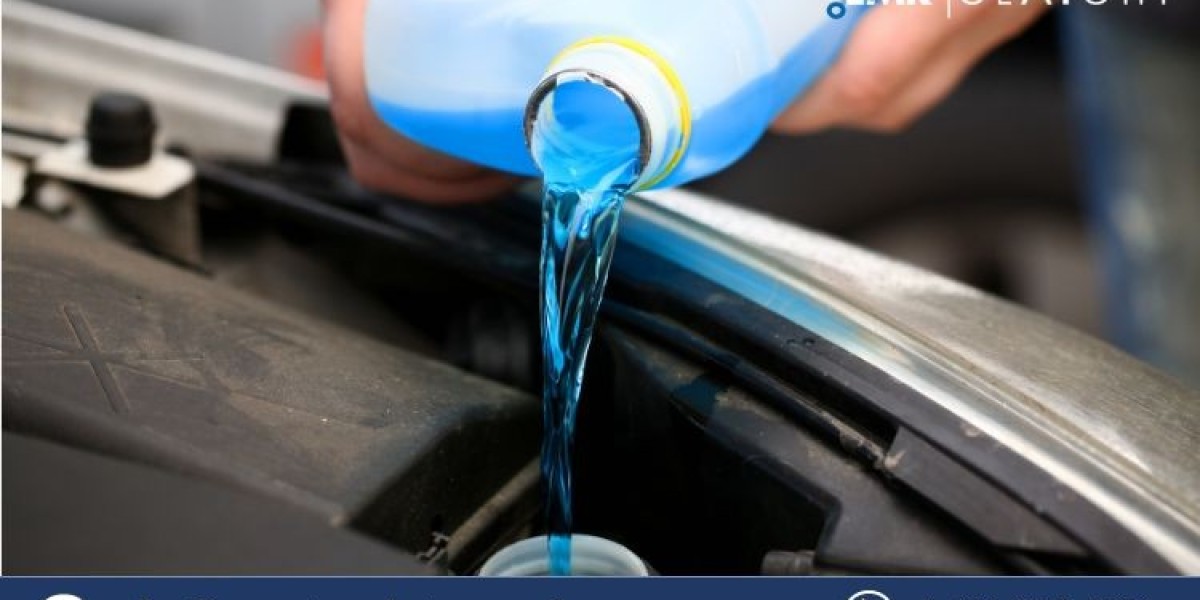The global antifreeze market size reached approximately USD 7.68 billion in 2023. Projected to grow at a compound annual growth rate (CAGR) of 6.7% between 2024 and 2032, the market is expected to attain a value of around USD 13.80 billion by 2032. This comprehensive blog explores the market outlook, report overview, market size, market dynamics, drivers, challenges, segmentation, recent developments, component insights, end-user insights, regional insights, key players, market trends, industry news, application insights, and answers to frequently asked questions.
Market Outlook
Antifreeze, a crucial component in automotive and industrial applications, prevents the freezing of liquids in engines and heat exchangers. The global antifreeze market is expanding due to increased vehicle production, the growing automotive sector, and rising demand for high-performance engine coolants. The market is also driven by technological advancements in antifreeze formulations that enhance engine efficiency and longevity.
Report Overview
This report provides an in-depth analysis of the global antifreeze market from 2024 to 2032. It covers market size, growth projections, key market dynamics, segmentation, recent developments, component insights, end-user insights, regional insights, key players, market trends, industry news, application insights, and detailed answers to frequently asked questions.
Market Size
The global antifreeze market was valued at approximately USD 7.68 billion in 2023. It is expected to grow at a CAGR of 6.7% during the forecast period, reaching around USD 13.80 billion by 2032. This substantial growth is attributed to the increasing production and sales of vehicles, the expansion of the automotive industry, and the rising demand for effective engine coolants.
Market Dynamics
Market Drivers
Growth in the Automotive Industry: The increasing production and sales of passenger and commercial vehicles globally are driving the demand for antifreeze.
Technological Advancements: Innovations in antifreeze formulations, including long-life and environmentally friendly coolants, are enhancing market growth.
Rising Industrialization: The growth of industrial sectors, including construction and manufacturing, is increasing the demand for antifreeze for industrial applications.
Climate Variations: The need for antifreeze is higher in regions with extreme temperatures, both hot and cold, driving market demand.
Key Market Challenges
Environmental Regulations: Stringent regulations regarding the disposal and environmental impact of antifreeze can pose challenges for market growth.
High Maintenance Costs: The maintenance and replacement costs associated with antifreeze can be high, impacting its adoption.
Availability of Substitutes: The presence of alternative cooling solutions can affect the demand for traditional antifreeze products.
Market Segmentation
The global antifreeze market can be segmented based on product type, technology, application, end-user, and region.
Product Type
- Ethylene Glycol
- Propylene Glycol
- Glycerin
- Others
Technology
- Organic Acid Technology (OAT)
- Hybrid Organic Acid Technology (HOAT)
- Inorganic Acid Technology (IAT)
Application
- Automotive
- Industrial
- Aerospace
- Others
End-User
- Passenger Vehicles
- Commercial Vehicles
- Heavy Machinery
- Industrial Equipment
Region
- North America
- Europe
- Asia-Pacific
- Latin America
- Middle East & Africa
Recent Developments
Eco-Friendly Formulations: Companies are developing environmentally friendly antifreeze formulations that are less toxic and more biodegradable.
Product Innovations: Advances in technology have led to the development of high-performance antifreeze products that offer superior protection and efficiency.
Strategic Partnerships: Key players are entering into strategic partnerships and collaborations to expand their product offerings and market reach.
Component Insights
Ethylene Glycol
Ethylene glycol is the most commonly used antifreeze component due to its excellent heat transfer properties and affordability. However, it is toxic and requires careful handling and disposal.
Propylene Glycol
Propylene glycol is a less toxic alternative to ethylene glycol, making it suitable for applications where safety is a concern. It is increasingly being used in automotive and industrial applications.
Glycerin
Glycerin-based antifreeze is known for its biodegradability and non-toxicity, making it an environmentally friendly option. However, it is more expensive than other alternatives.
End-User Insights
Passenger Vehicles
Passenger vehicles represent the largest end-user segment for antifreeze, driven by the increasing production and sales of cars worldwide.
Commercial Vehicles
The commercial vehicle segment is also a significant consumer of antifreeze, with demand driven by the need for efficient engine cooling in trucks, buses, and other commercial vehicles.
Heavy Machinery
Heavy machinery used in construction, mining, and agriculture requires robust antifreeze solutions to maintain optimal operating temperatures and prevent engine damage.
Industrial Equipment
Industrial equipment used in various sectors, including manufacturing and power generation, relies on antifreeze to ensure efficient and reliable operation.
Regional Insights
North America
North America holds a significant share of the global antifreeze market, driven by the high production and sales of vehicles, advanced automotive industry, and technological innovations.
Europe
Europe is a key market for antifreeze, with strong demand from the automotive and industrial sectors. The region is also witnessing increasing adoption of environmentally friendly antifreeze solutions.
Asia-Pacific
The Asia-Pacific region is expected to witness the highest growth rate during the forecast period, owing to rapid industrialization, increasing vehicle production, and rising demand for high-performance coolants.
Latin America
Latin America is emerging as a potential market for antifreeze, driven by the growing automotive industry and increasing industrial activities.
Middle East & Africa
The Middle East & Africa region is gradually adopting advanced antifreeze solutions, with significant potential for growth due to increasing investments in the automotive and industrial sectors.
Key Players
- Royal Dutch Shell PLC
- CCI Corporation
- BASF SE
- Old World Industries Inc.
- KMCO LLC
- Sonax GmbH
- Others
Market Trends
Sustainability Initiatives: There is a growing trend towards sustainable and environmentally friendly antifreeze solutions, driven by increasing regulatory pressures and consumer awareness.
Technological Advancements: Advances in antifreeze formulations and the development of long-life coolants are enhancing product performance and efficiency.
Expansion in Emerging Markets: Companies are expanding their operations in emerging markets to tap into the growing demand for antifreeze in these regions.
Industry News
Regulatory Approvals: Companies are focusing on obtaining regulatory approvals for new antifreeze formulations to ensure compliance with environmental standards.
Product Launches: Leading players are launching new and innovative antifreeze products to cater to the evolving needs of consumers and enhance their market presence.
Strategic Collaborations: Companies are entering into strategic collaborations and partnerships to strengthen their market position and expand their product portfolios.
Application Insights
Automotive
In the automotive sector, antifreeze is used to regulate engine temperatures, prevent overheating, and protect against corrosion and freezing. The increasing production and sales of vehicles are driving demand in this segment.
Industrial
In industrial applications, antifreeze is used in machinery and equipment to maintain optimal operating temperatures and ensure efficient performance. The growth of industrial sectors is boosting demand in this segment.
Aerospace
In the aerospace industry, antifreeze is used in aircraft cooling systems to prevent freezing at high altitudes and ensure safe and efficient operation. The increasing demand for aircraft is driving growth in this segment.
FAQs
1. What is antifreeze and why is it important?
Answer: Antifreeze is a liquid used in engines and heat exchangers to lower the freezing point and raise the boiling point of the coolant, preventing the system from freezing or overheating. It is crucial for maintaining optimal operating temperatures and protecting against corrosion.
2. What are the key drivers of the antifreeze market?
Answer: Key drivers include growth in the automotive industry, technological advancements, rising industrialization, and climate variations that increase the need for antifreeze in extreme temperatures.
3. What are the main challenges faced by the antifreeze market?
Answer: Main challenges include stringent environmental regulations, high maintenance costs, and the availability of alternative cooling solutions.
4. Which regions are expected to witness significant growth in the antifreeze market?
Answer: The Asia-Pacific region is expected to witness the highest growth rate, followed by North America and Europe. Latin America and the Middle East & Africa also show potential for growth.
5. Who are the major players in the global antifreeze market?
Answer: Major players include Royal Dutch Shell PLC, CCI Corporation, BASF SE, Old World Industries Inc., KMCO LLC, and Sonax GmbH.
6. What recent developments are shaping the antifreeze market?
Answer: Recent developments include eco-friendly formulations, product innovations, strategic partnerships, and expansion in emerging markets.








